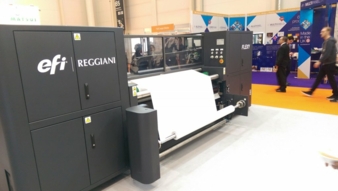19/07/2017 – Fespa — auf Deutsch lesen
Innovations in digital textile printing
Fespa, the leading European fair for screen and digital printing, opened its doors from 8-12 May 2017 in Hamburg. I
t not only focused on wide-format printing but also featured several innovations in digital textile printing.
Focus: Printer manufacturers
These exhibitors primarily presented solutions for the large-format advertising sector and applications such as flags, banners, shop design and retail/POS, that is, printing systems for direct sublimation printing on polyester fabrics in widths of up to 5 metres. The exhibits included, for example, the new AGFA 3.2m-wide, six-colour Avinci DX3200 sublimation printer with Konika-Minolta printheads. Supplied with AGFA’s own inks and its own Asanti RIP software, this printer provides the market with another all-round system for wide-format textile printing. Lüscher-Tschudi, a Swiss producer of digital printers, exhibited its 320cm-wide Raptor, which has been designed as an entry model specifically for the soft signage industry and features 4-8 Konika-Minolta printheads. The corresponding fixing system, the Therminator, is also available in an off-line version in a width of 320cm.
Durst and ATP showcased direct printing solutions that use sublimation inks for completely new formats in widths up to 5 metres. Whereas Durst has based its Rhotex 500 on the tried-and-trusted Rhotex 325, ATP has built an inline fixing system with integrated calender into its 5-metre-wide DFP2000 4-colour printer. This demonstrates that digital textile printing has finally arrived in the field of large-format printing, and is here to stay. MS unveiled the Impress series which is designed with printing systems up to 320cm in width and Kyocera printheads. This is the first product to emerge from the collaboration between those companies organised within the Dover Group which, among others, is composed of MS (printers), JK-Group (inks) and Caldera (RIP software).
New printers designed specifically for textile applications were presented by efi-Reggiani. The Renoir Flexy has a Kyocera printhead and is suitable for the industrial scale printing of flexible materials such as jersey with Lycra for swimwear and sportswear. The special fabric feed and a thermoplastic adhesion device hold the fabric in place to prevent creasing and distortions during the printing process.
Aleph is an Italian manufacturer of industrial textile printing systems and a newcomer to the market: the printers from the LaForte series come with Kyocera printheads and are designed both for industrial transfer printing and industrial direct printing on a wide variety of different textiles from fashion and home textiles to sports fabrics. Printing takes place with 4, 6 or 8 colours (reactive, acid, pigment, sublimation and dispersion inks).
Mimaki revealed the new TX300P hybrid printer as a particularly flexible solution, which allows both sublimation and pigment inks to be processed on one printer at the same time without the need to change the inks. Given that the fixing conditions for both ink systems are almost identical, the user can print cotton, polyester and polyester blends, e.g. for home textiles, on one machine.
Media
Being that Fespa revolves almost entirely around the world of advertising, it is hardly surprising that the exhibitors of printing media mainly focused on advertising textiles. Even so, the tried-and-trusted display, banner and block-out materials were also joined, in some instances, by materials for interior design and architecture: KREA, for example, showed a whole host of innovative interior design solutions as well as ideas for outdoor areas. Pongs revealed its textiles for rooms requiring special acoustics, lending acoustic room partitions completely new designs. However, visitors going in search of textile media other than polyester, struggled to find what they were looking for in Hamburg. Only the UK company Premier Textiles offered fabrics made from cotton, linen, silk and viscose, all of which are already pre-treated for reactive, acid, and pigment printing.
An important medium for digital textile printing is transfer paper for sublimation printing. French manufacturer Guyenne Papier has introduced a new addition to the market, which is suitable for home textiles, fashion and sportswear printing on all high-speed industrial printers. Felix Schoeller has also stepped inside the sublimation ring by offering the S-Race microporous sublimation paper. The papers designed for transfer printing are characterised by particularly short drying and transfer times, as well as good dimensional stability.
Ready-to-wear items such as shirts and headgear can also be transfer printed. Exhibiting at ColGraphix’s stand, Vapor Apparel showed its range of Vapor-Solar sublimation textiles, which are characterised by high levels of colour-fastness and a large colour space. Elsewhere, manufacturers were offering printing systems for the printing of made-up T-shirts. Kornit rises above the crowd with the Vulcan which is designed for industrial printing volumes of around 250 units/hour in seven colours and on light or dark ground colours.
The next Fespa is scheduled to run in Berlin from 15-18 May 2018 and will surely have a stronger focus on textile printing solutions.
Read more about the fair in our printed issue (appears 30th July)
Stephan Geitel




